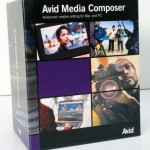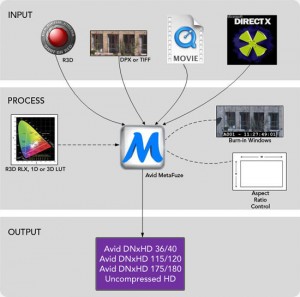Blog Archives
Avid Makes Big Changes with Release of Media Composer 5
 Final Cut lost one of it’s better selling features with the release of Avid’s Media Composer v5. Although Final Cut still retains it’s “one stop studio” (similar to that of the more consumer used Adobe Production Suite), Avid has now incorporated the drag and drop format for video and audio along with the ability to import footage without having to transcode. The latter being one of the biggest complaints of Final Cut users when working with Media Composer, since the ability to just grab (most) video formats and simply import them into your project in seconds has always been a primary function of workflow with FCP. Well, now Avid has finally added this convenient little feature to v5, and it will certainly take a little wind out of the sails of Final Cut’s ambitious climb to topple Avid in the post production market.
Final Cut lost one of it’s better selling features with the release of Avid’s Media Composer v5. Although Final Cut still retains it’s “one stop studio” (similar to that of the more consumer used Adobe Production Suite), Avid has now incorporated the drag and drop format for video and audio along with the ability to import footage without having to transcode. The latter being one of the biggest complaints of Final Cut users when working with Media Composer, since the ability to just grab (most) video formats and simply import them into your project in seconds has always been a primary function of workflow with FCP. Well, now Avid has finally added this convenient little feature to v5, and it will certainly take a little wind out of the sails of Final Cut’s ambitious climb to topple Avid in the post production market.
Read More
Avid Introduces New Versions for Media Composer and Symphony
 Avid has just announced the launch of version 4 for Media Composer and Symphony to the masses. This new upgrade of Media Composer and Symphony offer improved stereoscopic 3D editing, enabling customers to view 3D material side by side in addition to over/under — ensuring greater accuracy of editing decisions and a wider choice of cost-effective monitors for stereoscopic viewing. Mix and Match is a new function which provides customers with the flexibility to use media sources of different frame rates and resolutions (SD and HD) in the same timeline – eliminating external transcoding and time-consuming frame-rate conversions. Users can monitor HD and SD cross-and-down converted formats from 1080p24 masters. This enables customers using Mojo DX or Nitris DX hardware to view HD material on a less-expensive SD monitor.
Avid has just announced the launch of version 4 for Media Composer and Symphony to the masses. This new upgrade of Media Composer and Symphony offer improved stereoscopic 3D editing, enabling customers to view 3D material side by side in addition to over/under — ensuring greater accuracy of editing decisions and a wider choice of cost-effective monitors for stereoscopic viewing. Mix and Match is a new function which provides customers with the flexibility to use media sources of different frame rates and resolutions (SD and HD) in the same timeline – eliminating external transcoding and time-consuming frame-rate conversions. Users can monitor HD and SD cross-and-down converted formats from 1080p24 masters. This enables customers using Mojo DX or Nitris DX hardware to view HD material on a less-expensive SD monitor.
Avid has also added support for Panasonic AVC-I and Ikegami GFCAM 100MBps formats. The Production Suite versions have been updated to include new versions of Boris Continuum Complete, Sorenson Squeeze and SmartSound SonicFire Pro. On a side note Avid has also introduced new versions of its NewsCutter editor for news broadcasters and Interplay production asset management system.
Interplay 2.0 was upgraded as well which lets broadcasters and post facilities work remotely. Lower bandwidth streaming proxies let Interplay workgroup members work with media anytime from anywhere, using a Mac or PC. Of the numerous added feature of Interplay one which stands out for me is the feature of Final Cut Pro workflow support that offers check-in and check-out of FCP media with project links as well as media and metadata conversion of FCP-to-Avid and Avid-to-FCP projects.
Since FCS 3.0 was recently released, curious minds were wondering when Avid would respond to the Apple’s well received upgrade and they certainly have seemed too. Media Composer and Symphony will be available on September 30. I’ll give a full review when its public.
Credit to the Digital Arts Staff for the specifics of the release.
Has the World Gone 3D mad?
 It seems as if every movie that’s hitting theatres these days has a 3D version playing somewhere, but what does this mean to the editor? The majority of experienced editor’s have worked in most formats and genre’s by now and most have even decided to learn at least the basics of effects and motion graphics to keep up with the growing expectations of post houses. Now, along comes 3D, and the trend in Hollywood seems to be releasing films in both 3D and 2D versions to please the masses who have latched on to this one time gimmick…but, will it last? Back in the eighties 3D was a quick fad, showing up in selected films and then was gone quicker than Corey Haim’s career. Now it’s back, and with significant improvements to the theatrical viewing experience, the question is growing, will this become the new standard of film and even broadcast? Yes, that’s right, broadcast. If you don’t know already, the NFL is already experimenting with 3D football games having filmed several in the new format last season. Some television studios have already decided to broadcast the occasional show in 3D ( such as the show ‘Chuck’ from Virgin Media) and more and more companies are turning to 3D as a way of being able to provide more of a visual index to their clients.
It seems as if every movie that’s hitting theatres these days has a 3D version playing somewhere, but what does this mean to the editor? The majority of experienced editor’s have worked in most formats and genre’s by now and most have even decided to learn at least the basics of effects and motion graphics to keep up with the growing expectations of post houses. Now, along comes 3D, and the trend in Hollywood seems to be releasing films in both 3D and 2D versions to please the masses who have latched on to this one time gimmick…but, will it last? Back in the eighties 3D was a quick fad, showing up in selected films and then was gone quicker than Corey Haim’s career. Now it’s back, and with significant improvements to the theatrical viewing experience, the question is growing, will this become the new standard of film and even broadcast? Yes, that’s right, broadcast. If you don’t know already, the NFL is already experimenting with 3D football games having filmed several in the new format last season. Some television studios have already decided to broadcast the occasional show in 3D ( such as the show ‘Chuck’ from Virgin Media) and more and more companies are turning to 3D as a way of being able to provide more of a visual index to their clients.
So back to the original question. What does this mean for an editor? Well, at the moment, very little. There is a niche market of editor’s who are being privy to this type of format, and they say there’s definitely a learning curve. When it comes into the edit room you do watch the footage with 3D glasses while your cutting, and you have to extrapolate from multiple screens to link together the final sequence. Basically cutting the left eye footage, then the right eye footage via linked timecode of course.
In terms of hardware and software, a lot of people who are working in 3D ( which is not many comparatively ) are using cheap workarounds such as Sony Vegas ( which is a nightmare ) and working with 3D animation in Adobe AE CS3 ( not recommended but gets the job done ). While these may provide some flexibility to those not wishing to shell out more money, Avid was pleased to announce the industries first Stereoscopic 3D editing with Media Composer.
“Delivering full support of stereoscopic workflows, which enables customers to acquire, edit and display stereoscopic (3D) material. Content can be displayed with stereo monitoring capabilities in both the composer window and full screen playback – eliminating the need for costly conforms previously required to screen 3D material.” – Avid
Along with Avid, Nvidia is starting to pump out high end graphics cards for workstations that can handle the heavy load required to edit in this format along with the ability to view it in full rez. On a side note , Sony has also gone ahead with plans to produce a 3D Blu-ray player and is waiting for the movie studios who were close to reaching agreement on the final format, a decision that is predicted will be finalised by the end of 2009. According to Sony, this would bring the format to consumer market in late 2010.
When you take all this in, yes, it does seem like the the 3D craze is more than just a passing fad this second time around, and from an editor’s perspective all of us are in for a crash course at some point. So consider this fair warning to the lot of us, companies are ramping up it’s use, Hollywood is not letting go, and the tech corporations are preparing for a mass consumer market. So just when you thought you knew it all, along comes a new thing, and this one could shape the way we see the editing room for a while to come.

 Another topic I keep hearing about from production and post production personnel is that “Avid can’t handle Red One footage…” While there was, and I stress was some truth to this at one point, Avid has made sure this is no longer an issue. The truth is, that Avid was always capable of handling Red One footage, there was just a bit of a workaround, which could be a hassle if not done properly, in order for an editor to bring the footage into the system. Now enter Avid MetaFuze. Similar to the Sony Clip Browser, Avid’s MetaFuze is a one-stop transcoding software provided free via download. Once download you simply load up the software and import the footage. MetaFuze will transcode any number of formats, from DPX, RED R3D, QuickTime and even stereoscopic 3D source files by converting your high-resolutions files to 10-bit or 8-bit uncompressed or Avid DNxHD media.
Another topic I keep hearing about from production and post production personnel is that “Avid can’t handle Red One footage…” While there was, and I stress was some truth to this at one point, Avid has made sure this is no longer an issue. The truth is, that Avid was always capable of handling Red One footage, there was just a bit of a workaround, which could be a hassle if not done properly, in order for an editor to bring the footage into the system. Now enter Avid MetaFuze. Similar to the Sony Clip Browser, Avid’s MetaFuze is a one-stop transcoding software provided free via download. Once download you simply load up the software and import the footage. MetaFuze will transcode any number of formats, from DPX, RED R3D, QuickTime and even stereoscopic 3D source files by converting your high-resolutions files to 10-bit or 8-bit uncompressed or Avid DNxHD media.